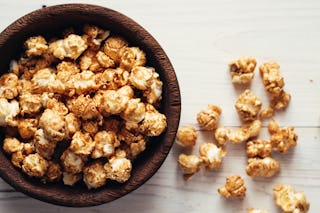
Candy is a big favorite around the holidays. We stuff it in stockings, give it as gifts, put it on our dessert tables, and set it out for Christmas parties.
But why have some types of candy become so popular for Christmas? And how did those candies come to be?
We’ve broken down the history and origins of some Christmas candy favorites for you!
Candy Canes
Candy canes are, of course, a Christmas staple! We hang them on our trees, stick them in Christmas stockings, and even use them as decorations. But did you know that candy canes originated in Germany?
It all started in 1670, when a kind choirmaster wanted a way to keep the children sitting quietly through a Christmas service. He made simple white sugar sticks into a “J” shape to resemble the crooks of the shepherds that visited baby Jesus, or so the story goes.

In 1847, a German immigrant to the U.S. became the first documented person to use candy canes as Christmas decorations – he hung them on his Christmas tree along with paper ornaments.
In the early 1900’s, red stripes appeared, and candy makers added peppermint flavoring.
Now, of course, we use candy canes everywhere, and it’s thought to have religious symbolism. The red is said to represent the blood of Jesus while the white is said to represent his purity.
Peppermint Bark
So what about peppermint bark – the addicting Christmas candy made of candy canes, dark chocolate, and white chocolate? It’s actually a relatively new invention, found in a Florida candy shop in the 1960’s, when it was sold year round.

Williams Sonoma made the candy famous in 1998, selling it only in the last few weeks of the year. They’ve sold more than five million packages in the last decade!
Fudge
While fudge isn’t limited to just the holidays, it’s certainly seen at Christmas dinner and found in stockings! It’s thought to be an American creation – the result of a batch of caramels that was “fudged” up. That’s how we got the name, too!

We started seeing fudge in a Baltimore grocery store around 1886. In 1888, a woman by the name of Emelyn Hartridge asked for the recipe from the store. She made it for a Senior Auction and it was so popular that the recipe spread across all the women’s groups in the area! The rest was history.
Peanut Brittle
Salty and sweet – the perfect combination! Peanut brittle is actually the result of another happy accident. Around 1890, a woman in the south was making taffy, but added backing soda instead of cream of tartar. She kept cooking the mixture, which made it hard (brittle!) instead of chewy.

But there’s also a popular folk story that involved a famous lumberjack named Tony Beaver. He was rumored to have stopped a flood using peanuts and molasses – the key ingredients of peanut brittle!
Chocolate Oranges
A chocolate orange is designed to look like a real orange but is really a ball of chocolate divided into segments with orange oil mixed in. Delicious!
The tradition of putting these sweet treats in stockings goes back to putting oranges themselves in stockings. In the original legend of Santa Claus, St. Nicholas was said to have given sacks of gold to three young girls who desperately needed money for their dowry. Oranges came to represent the gold that he so freely gave them!

Oranges also used to be difficult to come by in America, so getting one in a stocking was a wonderful, fruity treat! These famous chocolate oranges carry on this tradition today.
Ribbon Candy
Ribbon candy is a Christmas tradition that goes back centuries to Europe. Though it’s not clear exactly how it was invented, confectioners would use it to decorate their shops for the holidays, shaping the candy around their thumbs. In the 1800’s tools were invented to make the process even easier.

Eventually, it spread to New England and then all of America and, of course, most ribbon candy today is made using large machines and mass produced. Regardless, it’s a timeless Christmas candy that everyone loves!
Peppermint Nougat
We’ve all seen (and eaten!) these classic circular candies with green triangles designed to look like Christmas trees – they’re a classic part of our holiday!
Nougat is a French candy made with honey, sugar, nuts, and beaten egg whites. While the French made it popular, variations of nougat were found in the ancient writings of the Romans, all the way back to 1st-century AD! The first instance in France was around the 16th century. Known as “nogat”, the name came from “tu nous gates”, which means “you spoil us.”

Brach’s made the famous red and green peppermint nougats popular for the holidays and they’re seen in candy dishes all around the world!
Peppermint Patties
Peppermint patties are a wonderful combination of chocolate and mint that come out even more often around Christmas! And, of course, they originated with the York Cone Company, founded in 1920 Pennsylvania.

Henry Kessler, the owner, wanted to invent a new candy that would mix together chocolate and peppermint “in perfect harmony.” It was to be crisp, rather than gummy, like other candies of the time. In 1940, the peppermint pattie was distributed locally and took off! Eventually, York Cone Company stopped making cones and solely focused on the peppermint pattie. Now, York peppermint patties are owned by Hershey.
Caramel Corn
Is caramel corn a candy? We think so! We snack on it throughout the holidays, decorate our Christmas trees with it, and buy big Christmas tins as soon as Thanksgiving is over.

Caramel corn has its roots in kettle corn, which was seen for the first time with the Pennsylvania Dutch in the late 1700’s. They typically made the sweet popcorn for events, fairs, and holidays!
Then, in the 1870’s, two German brothers moved to the U.S. and opened a popcorn store. They wanted to experiment with different flavors, and ended up created molasses-covered Cracker Jacks! Those were so popular that others continued to experiment with different syrups and flavors, which is how caramel corn itself was created.